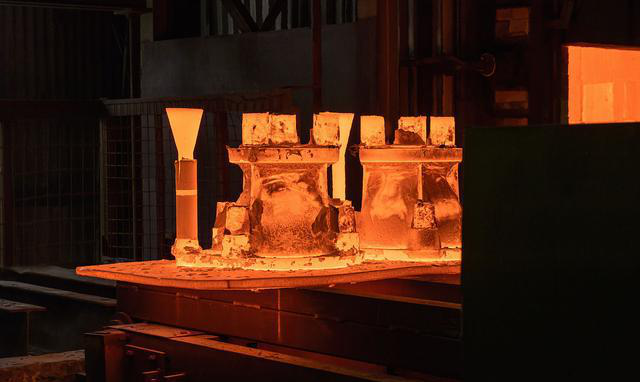
Heat treatment
Date:2019-10-24Article editor:Starting Point PrecisionViews:1869

Metal heat treatment processes can be roughly divided into three categories: overall heat treatment, surface heat treatment and chemical heat treatment. Depending on the heating medium, heating temperature and cooling method, each category can be divided into several different heat treatment processes. The same metal uses different heat treatment processes to obtain different microstructures and thus different properties. Steel is the most widely used metal in the industry, and the steel microstructure is also the most complex, so there are many kinds of steel heat treatment processes.
Overall heat treatment:
A metal heat treatment process that heats the workpiece as a whole and then cools it at an appropriate rate to change its overall mechanical properties. The overall heat treatment of steel has four basic processes: annealing, normalizing, quenching and tempering. Annealing, normalizing, quenching and tempering are the "four fires" in the overall heat treatment. Among them, the quenching and tempering are closely related, and often used together, they are indispensable.
Annealing is to heat the workpiece to the appropriate temperature, using different holding time according to the material and the workpiece size, and then slowly cooling, in order to achieve or close to the equilibrium of the internal structure of the metal, to obtain good process performance and performance, or to further quench Prepare for organization.
Normalizing is to cool the workpiece to a suitable temperature and then cool it in air. The effect of normalizing is similar to annealing, but the resulting structure is finer, which is often used to improve the cutting performance of low-carbon materials, and sometimes used for some low requirements. The parts are used as the final heat treatment.
Quenching is the rapid cooling of the workpiece after heating and holding it in a quenching medium such as water, oil or other inorganic salts or organic aqueous solutions. After quenching, the steel becomes hard but becomes brittle at the same time.
Tempering In order to reduce the brittleness of the steel, the quenched steel is kept warm for a long time at a suitable temperature above room temperature and below 650 ° C, and then cooled.
The “four fires” evolved different heat treatment processes with different heating temperatures and cooling methods. In order to obtain a certain strength and toughness, the process of combining quenching and high-temperature tempering is called quenching and tempering. After quenching some alloys to form a supersaturated solid solution, it is kept at room temperature or a slightly higher temperature for a longer period of time to increase the hardness, strength or electrical magnetic properties of the alloy. Such a heat treatment process is called aging treatment.
The method of effectively and tightly combining pressure processing deformation with heat treatment to obtain a good strength and toughness of the workpiece is called deformation heat treatment; the heat treatment in a vacuum atmosphere or vacuum is called vacuum heat treatment, which can not only make The workpiece is not oxidized, does not decarburize, keeps the surface of the workpiece smooth after treatment, improves the performance of the workpiece, and can also be subjected to chemical heat treatment by using an infiltrant.
Surface heat treatment:
A metal heat treatment process that heats the surface layer of the workpiece to change its surface mechanical properties. In order to heat only the surface layer of the workpiece without excessive heat being introduced into the interior of the workpiece, the heat source used must have a high energy density, that is, to give a large amount of heat energy to the workpiece per unit area, so that the surface layer or local portion of the workpiece can be short-time or instantaneous. Reach high temperatures. The main methods of surface heat treatment include flame quenching and induction heating heat treatment, commonly used heat sources such as aerobic acetylene or oxypropane, induction current, laser and electron beam.
Chemical heat treatment:
A metal heat treatment process that changes the chemical composition, structure, and properties of the surface of the workpiece. The difference between chemical heat treatment and surface heat treatment is that the latter changes the chemical composition of the surface layer of the workpiece. Chemical heat treatment is to heat the workpiece in a medium (gas, liquid, solid) containing carbon, nitrogen or other alloying elements for a long time, so that the surface of the workpiece penetrates into carbon, nitrogen, boron and chromium. After infiltration of the elements, other heat treatment processes such as quenching and tempering are sometimes performed. The main methods of chemical heat treatment are carburizing, nitriding and metalizing.
Heat treatment is one of the important processes in the manufacturing process of mechanical parts and tooling. It can control various properties of the workpiece, such as wear resistance, corrosion resistance, magnetic properties and so on. It also improves the microstructure and stress state of the blank to facilitate various cold and hot processing. For example, white cast iron can obtain malleable cast iron after long-time annealing treatment to improve plasticity; the gear adopts the correct heat treatment process, and the service life can be doubled or several times higher than that of the gear without heat treatment; in addition, the inexpensive carbon steel passes through Some alloying elements have some expensive alloy steel properties, which can replace some heat-resistant steels and stainless steels; almost all of the tooling tools need to be heat treated before they can be used.
Copyright © 2019 All Rights Reserved Dongguan Starting Point Precision Technology Co., Ltd. Tel: +86-769-82855591
Add: No. 332 Zhen'an Middle Road, Chang'an Town, Dongguan, Guangdong, China